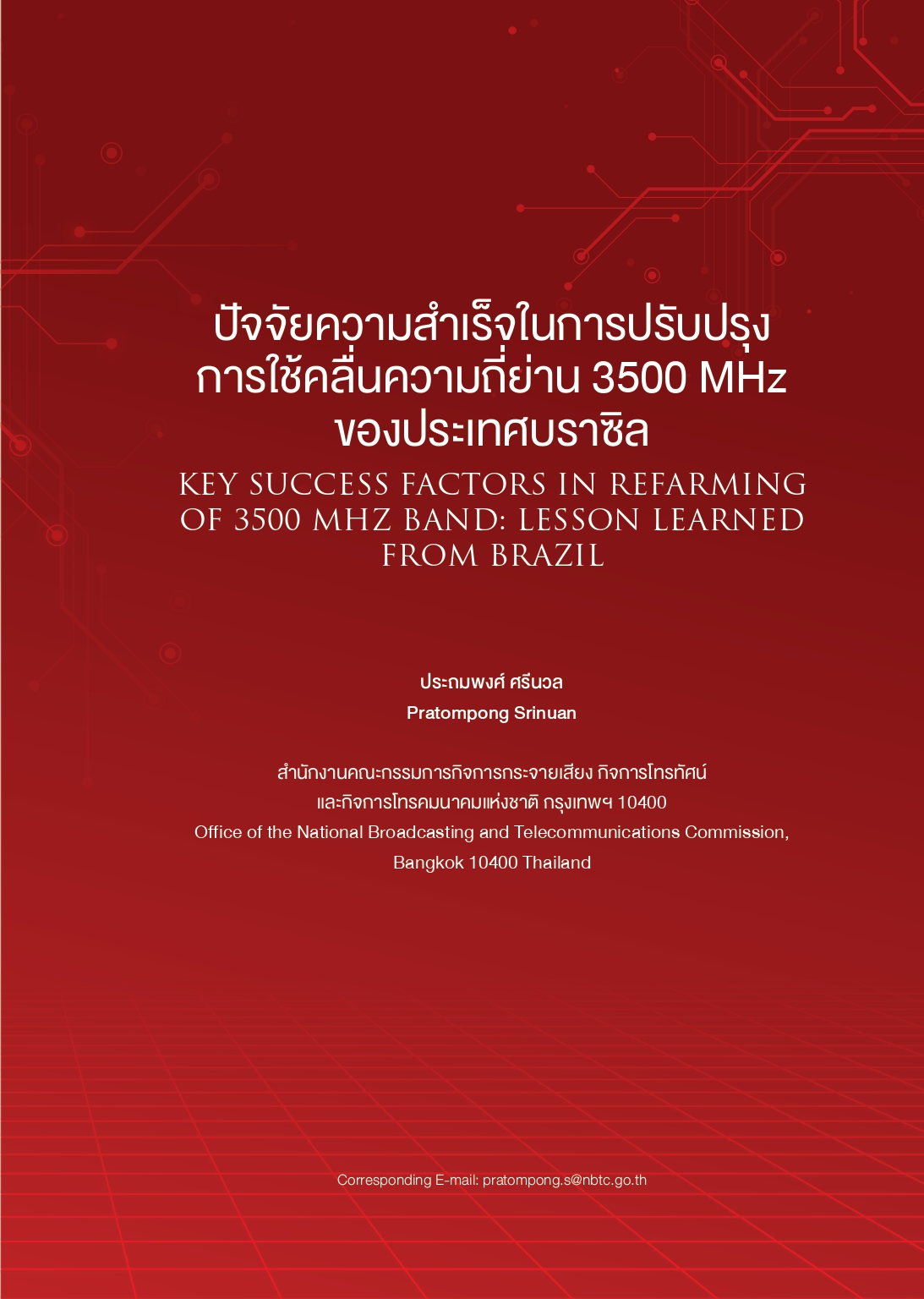ปัจจัยความสำเร็จในการปรับปรุงการใช้คลื่นความถี่ย่าน 3500 MHz ของประเทศบราซิล
คำสำคัญ:
การปรับปรุงการใช้คลื่นความถี่, ปัจจัยความสำเร็จ , คลื่นความถี่ย่าน 3500 MHzบทคัดย่อ
คลื่นความถี่ได้ถูกจัดสรรแก่กิจการโทรคมนาคมเคลื่อนที่สากลมากกว่า 600 MHz แต่ยังไม่เพียงพอกับการให้บริการด้วยเทคโนโลยี 5G คลื่นความถี่ย่าน 3500 MHz จึงได้ถูกกำหนดให้นำมาจัดสรรให้ใช้
ในเทคโนโลยี 5G ทั้งนี้ ปัจจุบันประเทศไทยยังมีการใช้งานคลื่นความถี่นี้ในการให้บริการโทรทัศน์ผ่านดาวเทียมและโทรคมนาคมประจำที่ จึงจำเป็นต้องมีการปรับปรุงการใช้คลื่นความถี่ย่าน 3500 MHz สหพันธ์สาธารณรัฐบราซิล (ประเทศบราซิล) มีการใช้งานคลื่นความถี่ดังกล่าวในการให้บริการรับชมโทรทัศน์ผ่านดาวเทียมมากกว่าร้อยละ 30 ของครัวเรือน และปรับปรุงการใช้คลื่นความถี่นี้ให้สามารถใช้งานร่วมกันระหว่างกิจการประจำที่ผ่านดาวเทียมและกิจการโทรคมนาคมเคลื่อนที่สากลได้สำเร็จ บทความนี้จึงศึกษาปัจจัยความสำเร็จของการปรับปรุงการใช้คลื่นความถี่ของประเทศบราซิล และนำเสนอแนวทางการปรับปรุงการใช้คลื่นความถี่สำหรับประเทศไทย โดยสัมภาษณ์ผู้มีส่วนร่วมในการปรับปรุงการใช้คลื่นความถี่ของประเทศบราซิล ผลการศึกษาพบว่า ปัจจัยที่ทำให้การปรับปรุงการใช้คลื่นความถี่ประสบความสำเร็จ ประกอบด้วย การระบุเหตุผลความจำเป็น วัตถุประสงค์ ตลอดจนการกำหนดทางเลือกที่เป็นได้ทั้งทางเศรษฐกิจและทางเทคนิค นอกจากนี้ การพิจารณาปัญหาการรบกวนกัน การหาแนวทางแก้ไขที่เป็นระบบโดยใช้หลักการทางวิทยาศาสตร์ และการมีส่วนร่วมของผู้มีส่วนได้ส่วนเสีย ก็เป็นปัจจัยสำคัญที่ทำให้การปรับปรุงการใช้คลื่นความถี่ดำเนินการได้สำเร็จ
เอกสารอ้างอิง
สำนักงานคณะกรรมการกิจการกระจายเสียง กิจการโทรทัศน์ และกิจการโทรคมนาคมแห่งชาติ. (2564). รายงานประเมินผลกระทบการปรับปรุงการใช้งานคลื่นความถี่ย่าน 3500 เมะเฮิรตซ์. https://www.nbtc.go.th
สำนักงานสถิติแห่งชาติ. (2562). สรุปผลที่สำคัญ การมีอุปกรณ์รับชมรายการโทรทัศน์ในครัวเรือน พ.ศ. 2562. http://www.nso.go.th/sites/2014/DocLib13/ด้านICT/เทคโนโลยีในครัวเรือน/2562/TV_62.pdf
GSMA. (2020). 5G and the 3.3-3.8 GHz Range in Latin America.https://www.gsma.com/spectrum/wp-content/uploads/2020/11/5G-and-3.5-GHz-Range-in-Latam.pdf
Handford, R. (2019a). Essential protection or throwback? Guard bands will free up the C-band. PolicyTracker. https://www.policytracker.com/essential-protection-or-throwback-guard-bands-will-free-up-the-c-band/
Handford, R. (2019b). China’s backing of 2.6 GHz for 5G could influence other countries. PolicyTracker.https://www.policytracker.com/chinas-backing-of-2-6-ghz-for-5g-could-influence-other-countries/
Handford, R. (2019c). Singapore’s proposed 5G band plan faces opposition. PolicyTracker. https://www.policytracker.com/singapores-proposed-5g-band-plan-faces-opposition/
Handford, R. (2019d). Singapore eyes 5G network rollout in 2020. PolicyTracker. https://www.policytracker.com/singapore-eyes-5g-network-rollout-in-2020/
Marti, M. R. (2019). Japan assigns 5G spectrum for $14.5 billion. PolicyTracker. https://www.policytracker.com/japan-assigns-5g-spectrum-for-14-5-billion/
Marti, M. R. (2021). Brazil puts $8.5 billion price tag on 5G spectrum. PolicyTracker. https://www.policytracker.com/brazil-puts-8-5-billion-price-tag-on-5g-spectrum/
Office of Communications (OFCA). (2019). Successful Conclusion of Auction of 5G Spectrum in 3.5 GHz band. https://www.ofca.gov.hk/en/news_info/press_releases/index_id_2005.html
Statista. (2021). Brazil: wireless service market share 2020, by operator. https://www.statista.com/statistics/758503/mobile-telephony-market-share-brazil-operator/
Tomas, J. P. (2021). Brazilian government confirms 5G auction for August: report. RCRWirelessNews.https://www.rcrwireless.com/20210701/5g/brazilian-government-confirms-5g-auction-august-report

ดาวน์โหลด
เผยแพร่แล้ว
รูปแบบการอ้างอิง
ฉบับ
ประเภทบทความ
สัญญาอนุญาต
ลิขสิทธิ์ (c) 2022 วารสารวิชาการ กสทช.

อนุญาตภายใต้เงื่อนไข Creative Commons Attribution-NonCommercial-NoDerivatives 4.0 International License.
บทความที่ปรากฏในวารสารกิจการสื่อสารดิจิทัล เป็นลิขสิทธิ์ของสำนักงาน กสทช. ซึ่งสำนักงาน กสทช. เปิดโอกาสให้สาธารณะหรือบุคคลทั่วไปสามารถนำผลงานไปเผยแพร่ คัดลอก หรือตีพิมพ์ซ้ำได้ ภายใต้สัญญาอนุญาตแบบเปิด (Creative Commons: CC) โดยมีเงื่อนไขสำหรับผู้ที่นำผลงานไปใช้ต้องระบุอ้างอิงแหล่งที่มา (Attribution: BY) ห้ามดัดแปลง (NoDerivatives: ND) และต้องไม่ใช้เพื่อการค้า (NonCommercial: NC) เว้นแต่ได้รับอนุญาตเป็นลายลักษณ์อักษรจากสำนักงาน กสทช.
อนึ่ง ข้อความ ตาราง และภาพที่ปรากฏในบทความซึ่งได้รับการตอบรับให้ตีพิมพ์และเผยแพร่ในวารสารนี้เป็นความคิดเห็นของผู้นิพนธ์ โดยไม่ผูกพันต่อ กสทช. และสำนักงาน กสทช. หากมีความผิดพลาดใด ๆ ผู้นิพนธ์แต่ละท่านต้องรับผิดชอบบทความของตนเองแต่เพียงผู้เดียว ไม่เกี่ยวข้องกับ กสทช. และสำนักงาน กสทช. แต่ประการใด


